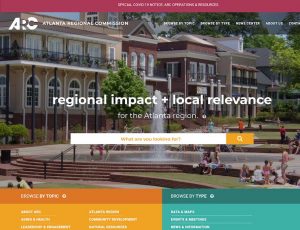A new population forecast for the 20-county metro Atlanta area prepared by the Atlanta Regional Commission (ARC) shows Coweta County’s 2040 population at nearly a quarter-million people, more than double the estimated 2010 population. Meantime, the population in the 20-county Atlanta area is expected to increase to 8.26 million during the same period, an increase of 57.1 percent over 2010.
ARC spokesperson Jim Jaquish in the Feb. 23 Regional Snapshot report noted that the Atlanta region has been one of the fastest-growing metro areas in the United States. And according to ARC’s new forecast that growth will only continue to occur. Referencing the report, Jaquish said the 20-county area, with a 2010 estimated population of 5,254,400, is expected to grow to 8,256,400 by 2040. That figure represents a population increase of 57.1 percent over current numbers.
Pertaining to Coweta County, the ARC forecast projects that the 2010 estimated population of 120,100 will increase by 107.2 percent to reach 248,500 by 2040. By way of comparison, Coweta’s population in 1980 was 39,268.
But what about Coweta’s neighbors? Fayette County, with a 2010 estimated population of 106,000 is forecast to see a 59 percent increase by 2040 with a population of 168,500. Carroll County is forecast to grow by 72.3 percent, going from a 2010 estimated population of 111,700 to 192,500 in 2040. And Fulton County is forecast to go from a 2010 estimated population of 965,600 to 1,338,900 in 2040, a 38.7 percent increase.
Jaquish said the continued growth will push the populations of two counties, Fulton and Gwinnett, past the one million mark. Today, Fulton, Gwinnett, DeKalb and Cobb counties account for 60 percent of the region’s population. While they will still hold the majority of the residents in 2040, their total share will drop to roughly 52 percent. Growth in some of the smaller counties accounts for that shift. In fact, five counties — Coweta, Forsyth, Henry, Newton and Paulding — will see their populations double by 2040, Jaquish said.
“Even in these tough economic times, the Atlanta region remains a place where people want to live and work,” said ARC Director Chick Krautler. “Our forecasts indicate continued strong population and employment growth for the next 30 years, and that’s good news for every city and county in the metro area.”
As with population, Fulton, Gwinnett, Cobb and DeKalb counties dominate the region’s employment today and will continue to do so. But the percentage of jobs in those counties will drop from 72 percent to 66 percent. Cherokee County will experience the highest percentage of job growth (166 percent), followed by Henry (141 percent), Barrow (133 percent) and Forsyth (124 percent) counties.
“Metro Atlanta, as one of the best-educated places in the U.S., is well prepared to meet the opportunities of the new globalized economy and to continue its strong growth,” said Mike Alexander, ARC’s Research Chief. “Our predecessors had the vision to invest in the future, creating opportunities for higher education that attract and keep entrepreneurs here and building what is now the world’s busiest airport, providing access to the rest of the world. These economic engines benefit the region and all of Georgia, and will be fundamental to our economic success.”
Metro Atlanta, including Coweta County, has for decades been the recipient of unprecedented population growth as the Northeast and Midwest states barely maintained long-held population levels. And all the while the Sunbelt states continued their population expansion.
The initial 2010 census figures released in January showed Georgia as America’s ninth most populous state with 9,687,653 residents. that figure compares to the 8,186,453 residents in 2000. Michigan, at number eight in 2010 had a population of 9,883,640.
The population forecasts will form the basis for ARC’s new 30-year regional plan, PLAN 2040, which will be adopted by the ARC Board of Directors in the summer of 2011. PLAN 2040 is being developed on a platform of economic, environmental and social sustainability for the entire Atlanta region.
For more details about ARC’s small area population and employment forecasts, including county-specific information visit www.atlantaregional.com/regionalsnapshot.










Leave a Comment
You must be logged in to post a comment.